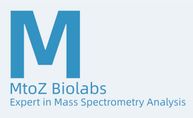
- Home
- Companies
- MtoZ Biolabs
- Services
- MtoZ Biolabs - Diacylglycerol Analysis ...

MtoZ Biolabs - Model dag-analysis - Diacylglycerol Analysis Service
Diacylglycerol (DAG), also known as diglyceride, consists of two fatty acid chains and a glycerol molecule. It primarily exists in two forms: 1,2-diacylglycerol and 1,3-diacylglycerol. DAG can be synthesized via the phosphatidic acid pathway in the endoplasmic reticulum by the action of phosphatidic acid phosphatase or produced during the lipolysis of triglycerides (TAG) by TAG lipase. DAG is also a crucial substrate for the biosynthesis of triglycerides, which are essential for energy storage, and phospholipids such as phosphatidylcholine (lecithin) and phosphatidylethanolamine, which are both vital for cell membrane structure.
DAG acts as a second messenger involved in the prolonged activation of various signal transduction pathways. The stereochemistry of DAG isomers influences their specific roles in metabolic processes. Diacylglycerol kinases (DGKs) play a significant role in cell signaling. It can terminates the signaling function of DAG to ensuring DAG's stable and controlled availability by phosphorylating DAG. One of the primary targets of DAG is protein kinase C (PKC). It has shown that DAG can enhance the activity of PKC, which in turn activates downstream targets via serine and threonine phosphorylation. Moreover, DAG is pivotal in membrane dynamics, such as inducing membrane fusion through partial dehydration of the bilayer surface and the increased lipid monolayer curvature.
DAG has been identified in various biological processes. Intracellular abnormal accumulation of DAG is positively correlated with disruptions in insulin signaling. Additionally, studies on transgenic obese animals have demonstrated that insulin resistance is associated with increased DAG levels in liver and muscle tissues. DAG is also implicated in the pathophysiology of cancer, neural signaling, and immune regulation. It is important to study DAG since its diverse roles in biological processes.
The LC-MS platform in can detect a wide range of DAG species, providing valuable data for studying relative changes in DAG concentrations, mechanistic insights, and biomarker discovery. Free project evaluation!MtoZ BiolabsMtoZ Biolabs employs robust, reproducible, and sensitive systems for the separation, characterization, identification, and quantification of DAG, ensuring reliable, rapid, and cost-efficient analyses.
1. Dilinoleoyl-Glycerol
2. Palmitoyl-Linoleoyl-Glycerol
3. Dipalmitoyl-Glycerol
4. Palmitoyl-Oleoyl-Glycerol
5. Stearoyl-Linoleoyl-Glycerol
6. Dioleoyl-Glycerol
7. Stearoly-Oleoyl-Glycerol
MtoZ Biolabs is an integrate contract research organization (CRO) providing advanced proteomics, metabolomics, bioinformatics, and biopharmaceutical analysis services to researchers in biochemistry, biotechnology, and biopharmaceutical fields. The name of MtoZ represents “mass to charge ratio” in mass spectrometry analysis, as most of our services are provided based on our well-established mass spectrometry platforms. Our services allow for the rapid and efficient development of research projects, including protein analysis, proteomics, and metabolomics programs.
MtoZ Biolabs is specialized in quantitative multiplexed proteomics and metabolomics applications through the establishment of state-of-the-art mass spectrometry platforms, coupled with high-performance liquid chromatography technology. We are committed to developing efficient, and effective tools for addressing core bioinformatics problems. With a continuing focus on quality, MtoZ Biolabs is well equipped to help you with your needs in proteomics, metabolomics, bioinformatics, and biopharmaceutical research. Our ultimate aim is to provide more rapid, high-throughput, and cost-effective analysis, with exceptional data quality and minimal sample.
Email: marketing@mtoz-biolabs.com
